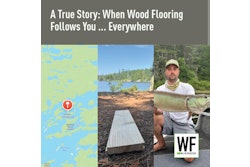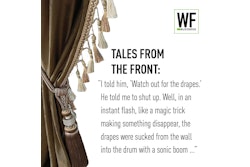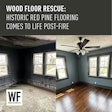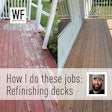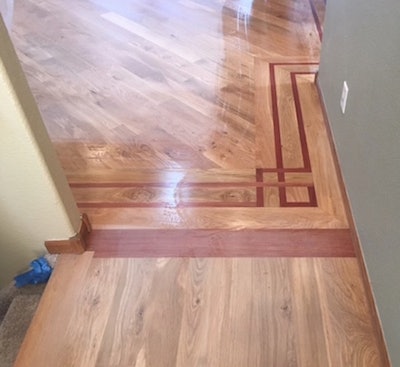
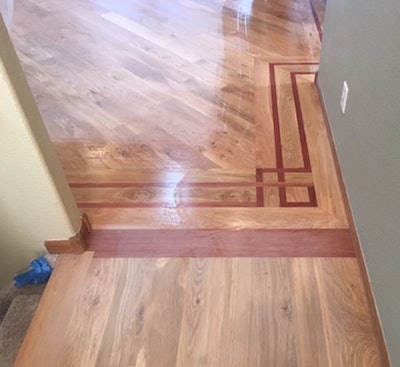
I’m a big fan of installing white oak as a species. I find the longer I’m in this industry, the more I like to promote the cleaner grades of wood, such as select and clear. My reasoning for this is they have longer average lengths, which equates to fewer butt joints (seams) in the floor, which, in my opinion, is more pleasing to the eye. Also, cleaner grades of wood have fewer qualities that tend to move and potentially cause issues over time (e.g. knots, wind shake, crotch wood, other variations in density and direction of grain).
Longer average lengths of wood install faster, with fewer fasteners needed to have the same holding power, since there are fewer fasteners being used up to secure the end of one short board and the beginning of the next. I have found that the cleaner grades of wood, with their longer average lengths, sand faster, too, while less knot patch, wood filler, and sandpaper is needed to prepare for stain and finish.
Fellow contractors, have any of you ever noticed a difference in morale on the job site between opening a 7-foot-long (2-meter-long) nested bundle of clear grade wood, with four straps holding it together, and a 7-foot-long nested bundle of third-grade wood, with 27 straps trying to hold it together?
To provide the materials, install, sand, stain, and finish, these days I find myself pricing #2 grade wood and select grade wood a lot closer to the same grand total price to the client than I did when I started years ago. My reasoning for this is because from start to finish, they end up costing me about the same to make look good and stand the test of time. Additional time spent racking out and cleating in lower grades, with their shorter average lengths, are factors. Boards I pay for and then sort out of the lower grades due to unsound knots, windshake, cracks through the face, spalted boards and end check are factors. Having to go to the time and expense of applying knot patch is a factor. Additional time and materials spent dealing with sanding a less uniform floor until it is up to my standards is a factor. Additional time and expense spent dealing with flake boards that rear their ugly heads after water-based finish is applied is a factor.
I am going to include some information about my pricing for this home that compares seven years ago to now. I will not normally be talking about specific prices on these posts, mainly because with inflation, those reading this 50 years from now will look at the figures and wonder how any of us did any of this work for so little. To put these figures into perspective, as of this writing in 2017, in my market there are multiple hardwood flooring companies who will provide solid hardwood, and install, sand, stain, and finish it for $5.45 per square foot ($58.66 per square meter).
My purpose in stating these figures is to prove that, although some companies still have the same skill sets as they did seven years ago and are still charging essentially the same as they did seven years ago, I decided to vastly change my mindset, my skill sets, and the tools that I use for the better, and charge more for what I do. Many (not all) potential clients recognize this, and are glad to pay me what I bid these days, and refer me to other clients that have the same mindset. I currently stay as busy as I want—although it’s the dead middle of winter here in Colorado, I’m currently booked out solid for two months.

I didn’t even have $5.00 per square foot budgeted for my labor ($54 per square meter). I wasn’t doing it to make a ton of business profit—I did it because wanted to break into the custom hardwood flooring market, which I have since successfully done. When I was doing primarily new construction floors at this time, my paradigm used to be along the lines of, “After all expenses, if I can pull down $1,000 per week, I can live with that.” I was running myself ragged to make it happen, too.
At that time seven years ago, 5-inch select white oak was around $4.00 per square foot ($43 per square meter). I felt that additional cost would have blown my whole bid out of the water and made it too costly to land the job. In the last seven years, I’ve had paradigm shifts about what all I bring to the equation, what my current skill sets are, what the supply of my skills and quality of my work is compared to the public demand for an accomplished craftsman is in my area. This time around, in the same home, with the same homeowners, I asked for $13.50 per square foot ($145 per square meter) for some rooms installed straight, with the living room on a 45-degree angle with custom borders, and I landed the bid. I fully completed the scope of work, within the time frame promised. With a hug from the wife and a hearty handshake from the husband, I drove away at the completion of the project with the final payment in hand.
As my paradigms have changed, many other aspects of my life have also changed. My skill sets have improved. My tools are higher quality, longer lasting and more user-friendly. My picture book that I show to prospective clients is alive with impressive pictures of what I have accomplished to date. I bring positive energy to the job site. I do the best I can every day. I understand that there has to be business profit and money set aside for retirement.
Although what I charged was a little over double what I did in this home seven years ago, my profitability per week was nearly triple. I attribute it to having a change of heart about gaining better skill sets in this trade, having a change of mind (paradigm shift) about what my time is worth, and having the confidence to bid in alignment with what an accomplished craftsman ought to be able to ask for and receive for compensation.
It's my personal belief that when anyone gets straight in their minds what they would like to change for the better, makes a reasonable plan for how to make that change a reality, then plugs in and works their plan to fruition, they can’t be stopped—the positive outcome is inevitable. The clients who recognize a craftsman and are willing to pay what he or she bids are out there. Now that my skill sets, tools, and mindset are to the point that I can deliver what they want, I work with these folks. We all benefit!

I look forward to questions, comments, and discussion that may arise from this and future blog posts. Feel free to comment below, and stay sharp!













